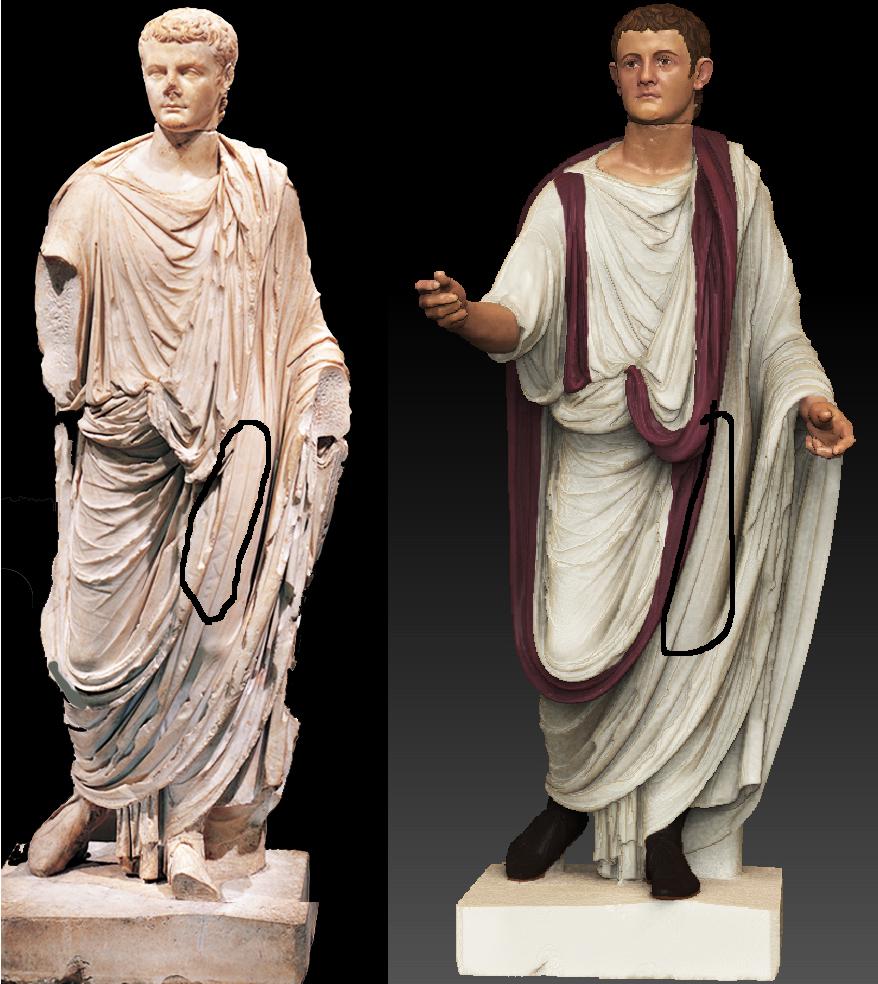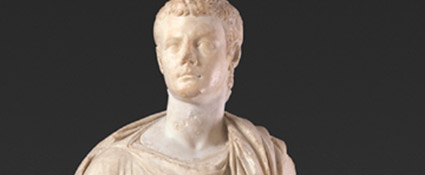Interviewer: What was the conservation project for Caligula?
Educator, Courtney Morano: Really where this stemmed from is we wanted to find traces of ancient pigment or ancient color on Caligula because we know from antiquity that sculptures were actually brightly painted.
Curator, Peter Schertz: Looking for traces of ancient color, we looked at the statue and thought “The sculpture has clearly been very carefully cleaned in the past,” but with all these deep channels in the folds and the drapery we were quite optimistic that we could find traces of ancient color because we know that this, like every other ancient marble statue had been painted.
Interviewer: What do we learn from this conservation project?
CM: We started to look for that paint and what we discovered is what we call Egyptian Blue and something called Pink Madder Lake. We did photo-induced luminescence, so again that different type of lighting, to figure out where the paint was. That’s literally all we found! On that whole sculpture, we found this teeny little piece, and it’s on his tunic.
Interviewer: Why is the painting such an important aspect? Why does that affect our understanding of these sculptures?
PS: In antiquity, every marble was painted and that was part of complete construction. An unpainted statue just wasn’t a full statue. There are stories about sculptors who said, “My best work is ‘such and such a statue’ because ‘so and so’ painted it.” So that is a sculptor saying “Paint is really the finishing to the whole of my statue, not just one part of making it.”
Interviewer: What color was found?
CM: So we have to sort of come up with three different ideas. We know the stripe was on the tunic, but what did his toga look like? It could be that he was wearing this kind of toga, white with a purple stripe, which was worn by certain senators, magistrates, consuls, high priests, certain upper class members. Or, he would have been wearing an all purple toga. Again, we don’t know, the paint wasn’t found on the toga. This is sort of saying he’s even higher level. Or potentially he was wearing something called a toga picta and that had a little bit of gold embroidery on it. That was worn by victorious generals, but adopted by emperors on very special occasions. So again, it says something different depending on which kind of toga he was wearing. It changes our opinion of what we think about him.
To view the full interview with curator, Dr. Peter Schertz, Click Here!

Caligula
Reproduction Study
VMFA Photo Resources
Conserving Caligula
On September 24, 2012, Peter Schertz requested Caligula’s head be removed from its body in order to properly re-position it. After removing the head, the conservators gained insight into understanding whether the head and torso came from the same block of marble. According to Kathy Gillis the proposed treatment included answering the following:
What was the simplified process of determining where the different pieces of marble came from?
- Documenting the condition of the Sculpture before and afterwards using digital and black and white photographs.
What was the step-by-step process, in layman’s terms, of the re-configuring of Caligula?
- The method settled upon for the removal of the head will include both a chemical and mechanical phase. The first phase will utilize a combination of dibasin esters as the solvent system, the dibasic esters will swell the adhesive that secures the joint allowing for it removal. The method required repeated applications of the solvent to the adhesive followed by its removal. In addition, some old adhesives were removed by utilizing a fine thread run through the joint in an effort to remove it from narrow portion of the joint. The stripper was cleared from the work area with acetone. This first phase was implemented in an effort to preserve physical evidence at the marble interface. The second phase utilized the cutting abrasive (carborundum) to severe the head from the torso. If the head is original it will be rejoined to the torso by utilizing a stainless steel pin set in a sleeve system using a re-soluble adhesive resin which will be dissolved in acetone and modified by the addition of fumed resin. Chipped areas of loss will be filled with pigmented plaster of Paris and those areas to be filled will first have Acryloid B-72 applied to the marble to facilitate removal of fills.
What was the conservation process and proposed treatment, in lay‘sman terms, for Caligula?
- Documenting the condition of the sculpture before and afterwards using digital and black and white photographs.
- Samples were taken from the sculpture for analysis using stable isotope ratio analysis to determine the likely provenance of the samples as well as determine if there is a similarity in the mineral and chemical compositions including crystal structures between the samples which were be sent to Scott Pike.
- Not the entire sculpture’s base was recovered in the excavation. The sculpture was inserted into a new supporting marble base so that the piece stands upright with an internal pin joining the pieces [base and sculpture] together.

Explore More:
Caligula: Scientific Research of History
Caligula: Extended Learning with Labs
Caligula: A Look into Roman Art History